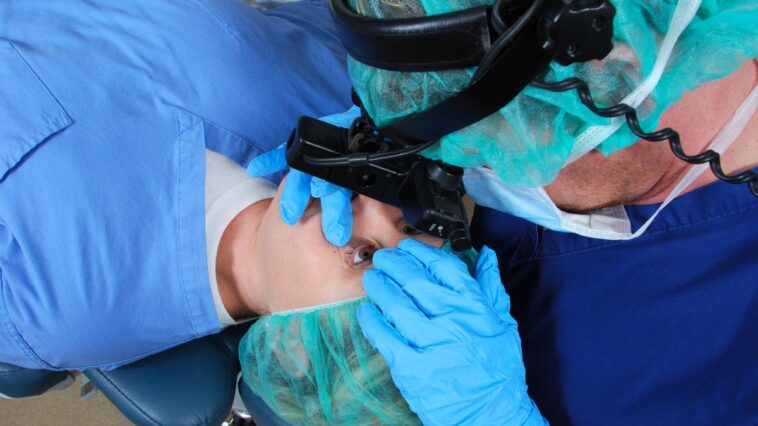The Benefits of LASIK Eye Surgery
LASIK is a type of refractive surgery that can correct nearsightedness, farsightedness, and astigmatism. Here are some of the benefits of LASIK eye surgery:
- Improved Vision: improve your vision and reduce your dependency on glasses or contact lenses. The procedure reshapes the cornea, the eye’s front surface, to correct refractive errors.
- Quick and Painless: LASIK surgery is a quick and relatively painless procedure that usually takes only about 15 minutes per eye. The procedure is performed under local anesthesia, so you’ll be awake without pain.
- Fast Recovery: Most patients experience a quick recovery after LASIK surgery. You’ll be able to return to your normal activities, including work, within a few days.
- Long-Lasting Results: LASIK surgery provides long-lasting results. Most patients achieve 20/20 vision or better after the procedure and maintain this level of vision for many years.
- Increased Self-Confidence: Correcting your vision through LASIK surgery can increase your self-confidence and quality of life. You’ll no longer have to worry about the inconvenience and expense of glasses or contacts.
- Safe and Effective: LASIK surgery is a safe and effective procedure for millions of patients worldwide. While every surgery carries some risks, the complications associated with LASIK surgery are rare and usually mild.
If you’re considering LASIK eye surgery, it’s essential to consult with an experienced eye surgeon to determine whether you’re a good candidate for the procedure. They can help you understand the risks and benefits of LASIK surgery and decide whether it’s the right choice for you.
How Does LASIK Eye Surgery Work?
LASIK is a surgical procedure that uses a laser to reshape the eye’s cornea, correcting vision problems such as nearsightedness, farsightedness, and astigmatism.
Here are the general steps involved in a LASIK procedure:
- Numbing the eye: The surgeon will administer numbing eye drops to ensure that you feel no pain during the procedure.
- Creating a corneal flap: The surgeon will use a microkeratome or a femtosecond laser to create a thin, circular flap in the cornea’s outer layer.
- Reshaping the cornea: The surgeon will use a laser to remove a small amount of tissue from the cornea, reshaping it to correct your specific vision problems.
- Replacing the corneal flap: The surgeon will gently fold it into its original position and smooth it down.
- Recovery: The surgeon will provide instructions on how to care for your eyes after the procedure. You may experience some discomfort, dryness, and temporary vision changes, but most people can return to normal activities within a few days.
LASIK surgery is a quick and relatively painless procedure that can be completed in less than 30 minutes per eye. The procedure aims to reshape the cornea to improve the eye’s focus on light, resulting in clearer vision.
Understand the Process and Risks Involved
LASIK eye surgery is a safe and effective procedure for correcting refractive errors. However, as with any surgery, there are some risks involved. Understanding the process and potential risks is essential before deciding whether to undergo LASIK surgery.
Process:
- Consultation: The first step in the LASIK process is a consultation with an eye surgeon. During this consultation, the surgeon will evaluate your eyes and determine whether you’re a good candidate for the procedure.
- Preparation: If you’re a good candidate for LASIK surgery, the surgeon will prepare your eyes for the procedure by creating a flap in the cornea. This is usually done using a laser.
- Reshaping: Once the flap is created, the surgeon will use a laser to reshape the cornea, correcting refractive errors.
- Recovery: After the procedure, you must rest briefly before leaving the surgery center. You must also follow post-operative instructions to ensure your eyes heal properly.
Risks:
- Dry eyes: LASIK surgery can cause dry eyes in some patients. This is usually a temporary condition that can be treated with eye drops.
- Infection: As with any surgical procedure, there’s a risk of infection. Your surgeon will provide you with instructions for preventing infection after the procedure.
- Undercorrection or Overcorrection: In some cases, LASIK surgery can result in undercorrection or overcorrection, which may require additional surgery.
- Vision Loss: Although rare, there is a risk of loss associated with LASIK surgery. However, the risk of vision loss is very low, and most patients experience improved vision after the procedure.
- Halos or Glare: Some patients may experience halos or glare around lights after LASIK surgery. This usually resolves within a few weeks.
- Flap Complications: In rare cases, complications can occur during the flap creation process, affecting the procedure’s outcome. Your surgeon will take steps to minimize the risk of flap complications.
It’s important to discuss the risks and benefits of LASIK surgery with your eye surgeon before making a decision. Your surgeon can help you understand the potential risks and determine whether LASIK surgery is right for you.
What To Expect Before, During, and After Surgery?
Before LASIK surgery:
- Consultation: Your eye doctor will evaluate your eyes to determine if you are a good candidate for LASIK surgery. You must provide information about your medical history and any medications you are taking.
- Pre-operative exams: You may need to undergo a series of pre-operative exams, including corneal topography and wavefront analysis, to determine the exact measurements of your eye.
- Preparation: Your eye doctor will provide you with detailed instructions on how to prepare for the procedure. This may include avoiding contact lenses and eye makeup before the surgery.
During LASIK surgery:
- Anesthesia: You will be given anesthetic eye drops to numb your eyes.
- Creation of the flap: Your eye surgeon will use a laser to create a flap on the cornea.
- Reshaping of the cornea: Your eye surgeon will use a laser to reshape the cornea to correct your vision.
- Closing of the flap: Your eye surgeon will carefully reposition and smooth it back into place.
After LASIK surgery:
- Rest: You will need to rest briefly after the procedure.
- Post-operative exams: You must undergo a series of post-operative exams to ensure your eyes heal correctly.
- Use of eye drops: You must use medicated eye drops to prevent infection and help heal.
- Recovery time: It may take several days or weeks for your vision to stabilize.
- Follow-up appointments: Your eye doctor will schedule follow-up appointments to monitor your progress and ensure that your vision is improving.
- Avoidance of certain activities: You must avoid certain activities, such as swimming and contact sports, for some time after the procedure.
Following your eye doctor’s instructions carefully before and after surgery is vital to ensure the best possible outcome. Contact your eye specialist immediately if you experience unusual symptoms or complications after the surgery.
Are You A Good Candidate For Lasik Surgery?
Whether or not you are a good candidate for LASIK surgery depends on several factors, including your age, overall health, and the severity of your refractive error. Here are some general factors that can determine whether or not you are a suitable candidate for LASIK:
- Age: LASIK surgery is typically recommended for adults over 18 whose vision has stabilized. If you are younger than 18, your vision may change, and LASIK may not be the best option.
- Refractive error: LASIK surgery is most effective for people with mild to moderate nearsightedness, farsightedness, and astigmatism. People with more severe refractive errors may not be good candidates for LASIK.
- Overall health: Your overall health is essential when determining if you are a good candidate for LASIK surgery. Certain medical conditions, such as autoimmune diseases or eye conditions like glaucoma or cataracts, may make LASIK surgery less safe or ineffective.
- Eye health: The health of your eyes is also an essential factor in determining whether or not you are a good candidate for LASIK surgery. LASIK may not be the best option if you have dry eye syndrome or other eye conditions.
- Expectations: It’s essential to have realistic expectations about the outcome of LASIK surgery. LASIK can significantly improve your vision, but it’s not a guarantee of perfect vision.
If you are considering LASIK surgery, the best way to determine whether or not you are a good candidate is to schedule a consultation with an experienced eye surgeon. They will be able to evaluate your case and help you determine if LASIK is the best option for you.
Can You Do Anything to Improve Your Chances of a Successful Procedure?
There are several things you can do to improve your chances of a successful LASIK procedure:
- Choose a reputable eye surgeon: Choose an experienced and reputable eye surgeon who is board-certified and has a good track record of successful LASIK surgeries.
- Follow your eye doctor’s instructions: Follow your eye doctor’s instructions carefully both before and after the procedure. This includes attending all pre-operative and post-operative appointments, using eye drops as prescribed, and avoiding certain activities.
- Be honest about your medical history: It’s essential, to be honest with your eye surgeon about your medical history and any medications you take. Certain conditions and medications can affect the outcome of the procedure.
- Have realistic expectations: Have realistic expectations about the outcome of the procedure. LASIK surgery can significantly improve your vision but does not guarantee perfect vision. Your eye surgeon can help you understand what to expect based on your case.
- Take care of your eyes: Taking care of your eyes before and after the procedure can improve your chances of success. This includes getting enough rest, eating a healthy diet, and avoiding smoking.
By following these tips, you can help ensure you have the best possible outcome from your LASIK procedure.
What Are the Costs Associated with LASIK Eye Surgery?
The cost of LASIK eye surgery can vary depending on several factors, such as the location, the experience and reputation of the surgeon, the technology used, and the severity of your refractive error.
LASIK surgery in the United States can cost between $2,000 and $4,000 per eye. Some insurance plans may cover a portion of the cost of LASIK surgery, but this is only sometimes the case. It’s essential to check with your insurance provider to see if LASIK surgery is covered under your plan and what portion of the cost may be covered.
It’s also important to consider the potential long-term cost savings associated with LASIK surgery. While the upfront cost of LASIK may seem high, the cost of glasses, contact lenses, and other vision correction methods can increase over time. LASIK surgery can provide a permanent solution to refractive errors, eliminating the need for ongoing costs associated with other vision correction methods.
If cost is a concern, some LASIK providers offer financing options to help make the procedure more affordable. However, it’s essential to consider the overall cost and weigh the potential benefits against the upfront cost before deciding.
Choosing a reputable and experienced eye surgeon is also important to minimize the risk of complications and ensure the best possible outcome.
Conclusion
LASIK eye surgery can be a safe and effective option for correcting vision problems such as nearsightedness, farsightedness, and astigmatism.
LASIK can be a life-changing procedure for suitable candidates and can help improve vision and reduce the need for ongoing vision correction methods. While it’s essential to understand the process and potential risks involved, many people experience improved vision and a higher quality of life after LASIK surgery.
Only some are good candidates for LASIK, and it’s essential to consult an experienced opthalmologist to determine if LASIK is the best option for your case. Cost can also be a consideration, but it’s crucial to weigh the potential long-term cost savings against the upfront cost of the procedure.






